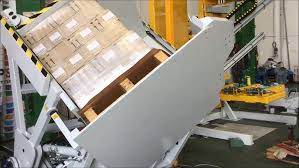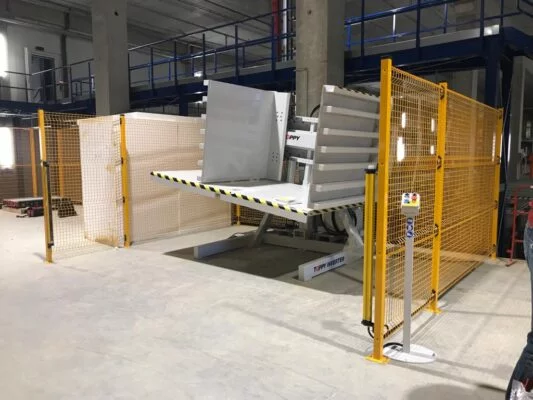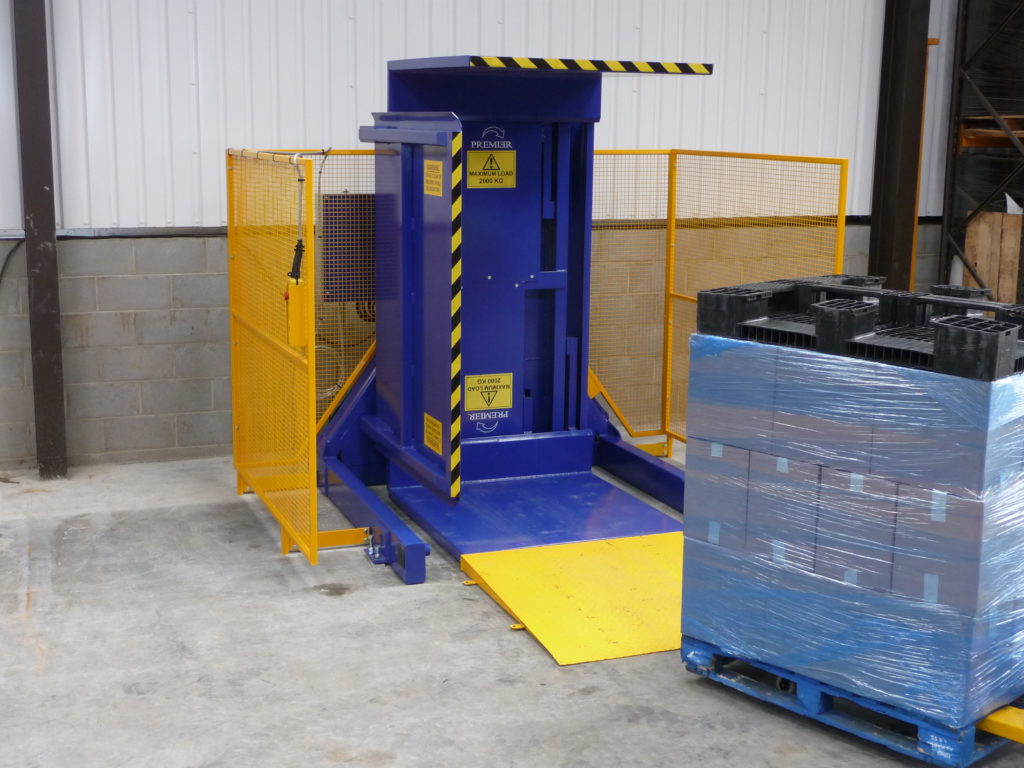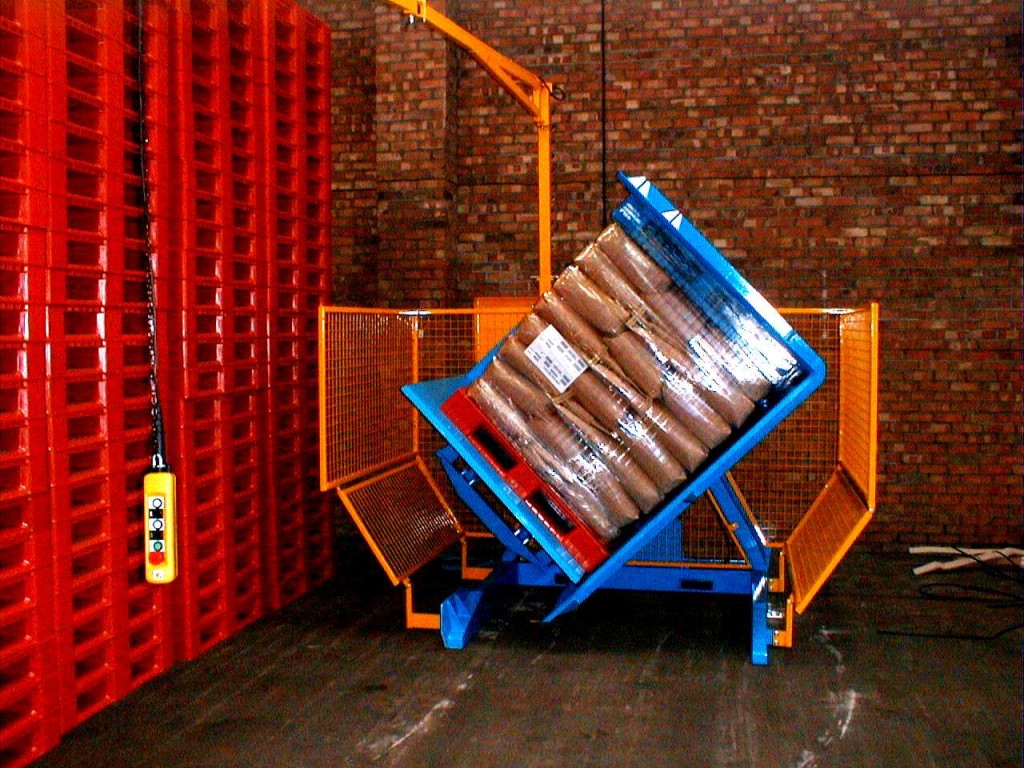Cutting Downtime in Saudi Arabia: How Pallet Changing Machines Help
Downtime in a busy production environment is a constant threat. In a demanding market like Saudi Arabia, a single disruption can have huge effects. Imagine a critical shipment, ready to go, but it's on the wrong type of pallet. Or worse, a broken wooden pallet enters your automated system, causing a complete shutdown. These small pallet issues create big, expensive problems that can stop your entire operation. This costs you money, wastes your team's time, and can damage your reputation with customers. But there is a straightforward and reliable way to prevent these issues. A pallet changing machine offers a simple solution to keep your production lines moving and protect your profits.
A pallet changing machine helps cut downtime in demanding environments like Saudi Arabia by quickly and safely transferring goods from one pallet to another. This process eliminates delays caused by damaged, non-compliant, or unsuitable pallets. By ensuring a continuous flow of materials, these machines are essential for modern production and logistics. They act as a gateway, making sure only the correct and safe pallets enter your workflow. This simple step protects your automated equipment and keeps your output on schedule.

This might sound like a simple fix, but its impact on your plant's efficiency and financial health is significant. When I started my journey as an engineer, I saw these "small" problems cause major headaches for factory managers. That's why I believe in finding robust solutions for them. Let's look closely at the specific problems a pallet changer can solve and how it can be a strategic asset for your business, especially in a fast-paced market like Saudi Arabia.
What specific operational bottlenecks can a pallet changer solve in a large-scale plant?
Your receiving dock is busy. A truck arrives with essential raw materials, but the pallets are a different size than your racking system uses. Or, you spot a pallet with a cracked board, a clear safety risk for your automated warehouse. These situations create immediate bottlenecks. Your team has to stop their work and manually restack the entire load. This process is slow, inefficient, and introduces the risk of product damage or worker injury. I have visited many plants where this exact scenario plays out daily, wasting valuable time and resources. A pallet changer is designed to solve these exact problems quickly and safely.
A pallet changer solves specific operational bottlenecks by enabling quick transfers between different pallet types. For example, it can switch loads from wood to plastic pallets for hygienic areas. It can handle damaged pallets without manual restacking. And it ensures loads meet specific export or internal handling standards. This prevents stoppages at critical points like automated storage systems, wrapping lines, or shipping docks. It turns a potential crisis into a routine, controlled process.

Dive Deeper: From Bottleneck to Smooth Flow
Let's break down how a pallet changer removes these common obstacles in a large-scale industrial facility, such as the ones I've worked with in the steel and manufacturing sectors across Asia and the Middle East.
Handling Inbound and Outbound Pallet Discrepancies
Many large plants in regions like Saudi Arabia operate in a global supply chain. You might receive materials from a European supplier on EURO pallets (1200x800mm). But your internal automated system and local distribution network might be standardized on US pallets (1219x1016mm) or other local sizes. This mismatch creates a significant bottleneck right at the receiving door. Without a pallet changer, your only option is manual restacking. This is not just slow; it's a huge drain on labor that could be used for more valuable tasks.
A pallet changer acts as a "pallet translator." The forklift operator places the entire load, pallet and all, into the machine. The machine securely clamps the product, rotates it, and allows the operator to easily remove the original pallet and replace it with the correct type. The entire process takes about a minute. This is a massive improvement over manual labor.
| Metric | Manual Pallet Exchange | Pallet Changer Exchange |
|---|---|---|
| Time per Pallet | 15-20 minutes | ~1 minute |
| Labor Required | 2-3 workers | 1 operator |
| Safety Risk | High (lifting, bending) | Low (automated process) |
| Product Damage Risk | Moderate to High | Very Low |
Isolating Damaged Pallets from the Production Flow
A single broken pallet can be incredibly destructive in a modern, automated factory. If a pallet with a protruding nail or a broken board enters an automated conveyor or an Automated Storage and Retrieval System (ASRS), the results can be disastrous. It can cause jams, damage expensive sensors, or even lead to a complete system shutdown that takes hours or days to fix. This is a critical risk for any operation aiming for high uptime.
A pallet changer serves as a quality control checkpoint. By placing a pallet changer at your receiving area, you can inspect every incoming pallet. Any pallet that looks weak, damaged, or unsafe can be immediately swapped for a new, reliable one. This is a proactive strategy. You are preventing downtime before it has a chance to happen. It's a simple form of predictive maintenance for your entire logistics workflow.
How does investing in a pallet changer align with long-term cost reduction goals?
As a factory owner, I know that every investment must be justified. You look at a piece of equipment and ask, "What is the return?" A pallet changer might seem like another capital expense. But I encourage you to look at it differently. Think about the hidden costs it eliminates. The cost of labor for manual restacking. The cost of product damaged during that process. The huge cost of downtime when a bad pallet shuts down your line. When you add up these savings, you'll find that a pallet changer isn't an expense. It's an investment in efficiency that pays for itself, often much faster than you'd expect.
Investing in a pallet changer aligns with long-term cost reduction by directly tackling several key operational expenses. It minimizes product damage from manual handling. It reduces labor costs tied to restacking. It can eliminate rental fees for third-party pallets. Most importantly, it prevents costly downtime in automated systems. These combined savings create a strong and rapid return on investment (ROI), directly supporting goals like lowering overall operating costs.

Dive Deeper: The Financial Case for Pallet Changers
A forward-thinking CEO or plant owner always analyzes the numbers. The decision to invest in new equipment must be backed by a clear financial benefit. Let's look at the specific ways a pallet changer contributes to your bottom line and helps achieve ambitious cost reduction targets.
Calculating the Return on Investment (ROI)
The ROI for a pallet changer is surprisingly easy to calculate once you identify the costs it offsets. My clients are often surprised by how quickly the machine pays for itself. Let's consider a hypothetical steel processing plant in Saudi Arabia that handles 100 inbound pallets per day, and 15% of them need to be restacked due to damage or type mismatch.
| Cost Category | Manual Method Costs (Per Day) | Pallet Changer Savings (Per Day) |
|---|---|---|
| Labor Costs | 15 pallets x 20 min/pallet x 2 workers @ $15/hr = $50 | Labor reduced by 90% = $45 saved |
| Product Damage | 1% of value on restacked goods (e.g., $2000/pallet) = $300 | Damage reduced by 95% = $285 saved |
| Downtime Avoidance | 1 major incident/year ($10,000 cost) = ~$40/day | Risk almost eliminated = ~$40 saved |
| Total Daily Savings | $370 |
With daily savings of $370, the annual savings would be over $96,000 (assuming 260 workdays). A robust pallet changer might cost between $30,000 and $60,000. In this scenario, the payback period is well under one year. This is the kind of hard data that justifies an investment.
Reducing Hidden Operational Costs
Beyond the direct ROI calculation, pallet changers reduce other costs that are harder to quantify but just as important.
- Workplace Safety and Ergonomics: Manual restacking of heavy loads is a primary cause of back injuries and other musculoskeletal disorders. These injuries lead to lost workdays, higher insurance premiums, and potential legal costs. A pallet changer automates the heaviest part of the job, creating a safer work environment for your team. A healthy team is a productive team.
- Pallet Pool Management: Many companies spend a lot of money on pallet rental programs like CHEP or PECO. Or they face penalties for not returning supplier pallets on time. A pallet changer allows you to immediately transfer goods to your own internal pallet pool at the receiving dock. This simplifies your logistics, gives you full control over your pallet inventory, and eliminates rental fees entirely. This single benefit can save thousands of dollars every month.
What are the key considerations when choosing the right pallet changer for a heavy industry environment?
Choosing new equipment is a critical decision. You wouldn't use a standard forklift to move massive steel coils, and the same principle applies here. A pallet changer designed for light goods in a distribution center will quickly fail in the demanding environment of a steel mill or a large-scale manufacturing plant in Saudi Arabia. The dust, the 24/7 operation, and the heavy loads require a machine that is built to last. Choosing the wrong machine is a waste of money and creates a new point of failure in your line. This is where my experience as both an engineer and a factory owner is most valuable.
The key considerations when choosing a pallet changer for heavy industry are its load capacity, its clamping system, its physical footprint, the level of automation required, and its overall durability. You must ensure the machine can safely handle your heaviest loads. The clamping mechanism must be powerful enough to hold the product securely but gentle enough not to damage it. And the machine must be built with high-quality components to withstand the harsh conditions of your plant with minimal maintenance.

Dive Deeper: Selecting a Machine That Works for You
As the founder of SHJLPACK, my philosophy is "TOTAL SOLUTION FOR WRAPPING MACHINE." This means I don't just sell a machine; I help my clients find the right machine for their specific problem. When it comes to pallet changers in heavy industry, the details matter.
Matching Machine Specifications to Your Load
This is the most fundamental step. You need to analyze your products and pallets carefully.
- Load Capacity: Always select a machine with a capacity that is at least 25% higher than your heaviest pallet load. This provides a crucial safety margin and reduces stress on the machine's components, leading to a longer service life. For industries like steel, cement, or chemicals, a capacity of 1500kg to 2000kg is common.
- Load Type and Stability: The nature of your product determines the best type of clamping system. A solid, stable load like a crate of parts might only need side clamps. But a stack of bags, boxes, or steel wire coils that could shift requires a machine with both side clamps and a top press. The top press applies gentle pressure from above to stabilize the entire load during the rotation process.
- Machine Footprint and Layout: Where will the machine go? You need to consider the space available. Some pallet changers require the forklift to load from the front. Others, like our FZ model, can be loaded from the ground with a pallet jack, making them more versatile. Inline models are designed to be integrated directly into a conveyor system and require more space.
Evaluating Build Quality and Maintenance Requirements
A machine in a heavy industrial setting will be subject to dust, vibrations, and continuous use. It must be tough.
| Quality Indicator | What to Look For (Good) | What to Avoid (Bad) |
|---|---|---|
| Frame Construction | Thick, welded structural steel frame. Powder-coated finish. | Thin, bolted sheet metal. Basic paint. |
| Hydraulic System | Reputable brands (e.g., Parker, Bosch Rexroth). Easily accessible components. | Unknown brands. Hoses and fittings in hard-to-reach places. |
| Control System | Siemens or Allen-Bradley PLC. Intuitive HMI screen. | Proprietary, complex controls. No clear diagnostic information. |
| Safety Features | Full safety fencing, light curtains at entry/exit points, emergency stops. | Basic guarding, no electronic safety interlocks. |
A well-built machine from a supplier who understands industrial needs will require less maintenance and have a much lower total cost of ownership. This is a core part of our design philosophy at SHJLPACK.
How can pallet changers integrate with existing automation and digital transformation strategies?
You are building a smart factory. You are investing in a Manufacturing Execution System (MES), deploying IoT sensors, and using data to make better decisions. In this vision, every piece of equipment should be part of the network. A standalone machine that cannot communicate is a "dumb" asset. It's a black hole in your data stream. But what if your pallet changer could become an intelligent node in your logistics network? What if it could receive commands from your WMS and report back on its status, contributing to your goal of full production visualization? This is not a future concept; it's possible today.
Pallet changers integrate with digital transformation strategies by connecting to a central MES or Warehouse Management System (WMS). Through this connection, they can receive automated commands, report cycle times and status, track pallet movements, and even trigger maintenance alerts using built-in IoT sensors. This turns the machine into a valuable data source, supporting a fully visualized, automated, and efficient production flow.

Dive Deeper: The Pallet Changer in an Industry 4.0 Factory
For a leader focused on digitalization, equipment integration is not a luxury; it's a requirement. A smart factory relies on seamless data flow between all its components. Here is how a modern pallet changer fits perfectly into that strategy.
The Pallet Changer as an IoT Data Node
A modern pallet changer is equipped with a PLC (Programmable Logic Controller) and various sensors. These are not just for basic operation; they are data collection points.
- Operational Data: The machine can track every cycle it performs. This data—cycle count, time per cycle, clamping pressure used—can be sent to your central system. This helps you monitor throughput and identify inefficiencies.
- Predictive Maintenance: This is a key goal for achieving 95% uptime. Sensors can monitor the hydraulic pressure, motor temperature, and the status of safety circuits. If the system detects a gradual drop in hydraulic pressure, it can send an alert to your maintenance team before it causes a failure. Your team can schedule repairs during planned downtime instead of reacting to a sudden breakdown.
Connecting to MES/WMS for a Seamless Workflow
The true power of integration is realized when the pallet changer communicates directly with your factory's brain—the MES or WMS. Imagine this fully automated workflow:
- A delivery truck arrives. Its manifest is scanned into the WMS.
- The WMS identifies that the incoming goods are on wooden pallets but need to be on internal plastic pallets for the ASRS.
- The WMS dispatches an AGV (Automated Guided Vehicle) to transport the pallet from the dock to the inline pallet changer.
- The WMS sends a command to the pallet changer to begin its cycle.
- The pallet changer performs the swap and signals to the WMS that the task is complete.
- The WMS then directs the AGV to move the new pallet to the ASRS entrance.
In this scenario, there is no manual intervention, no human error, and no wasted time. It is a perfect example of how physical automation (the pallet changer) and digital automation (the WMS) work together.
| Level of Integration | Description |
|---|---|
| Level 1: Standalone | Manual push-button operation. No data connection. |
| Level 2: Semi-Automated | PLC-controlled sequences. Can store basic fault codes locally. |
| Level 3: Connected | Connects to the plant network (e.g., via Ethernet/IP). Can receive commands and send status updates to an MES/WMS. |
| Level 4: Smart/Industry 4.0 | Full IoT sensor suite. Provides rich data for analytics, AI-driven optimization, and predictive maintenance. |
At SHJLPACK, we can provide solutions at any of these levels, depending on your current needs and future goals.
Conclusion
Pallet changers are more than just machines. They are strategic tools for boosting efficiency, cutting costs, and future-proofing your operations in demanding industrial environments like Saudi Arabia.
My Insights
Javier, I looked at your background, and I see a fellow engineer who built a business from the ground up with dedication and technical know-how. I respect that journey because I have walked a similar path, from an employee on the factory floor to the owner of my own successful packing machine factory.
The challenges you face—aging equipment, pressure on energy costs, and the urgent need for digital transformation—are the exact problems I have dedicated my career to solving. It’s never about just selling a piece of equipment. It’s about understanding the entire production line and finding the right solution that delivers real value. Your goal to increase uptime to 95% and reduce operating costs by 8% is ambitious but achievable with the right strategic investments in smart, reliable automation.
You are looking for a strategic partner, not just a supplier. This is the very core of my mission with SHJLPACK. I achieved my own success thanks to this industry, and now my goal is to share the knowledge I've gained to help leaders like you succeed. When your factory runs more smoothly and profitably, we both win. Let’s have a conversation, not about a single machine, but about your entire packaging and handling process. I am confident that my experience can help you find a total solution that meets your goals.




